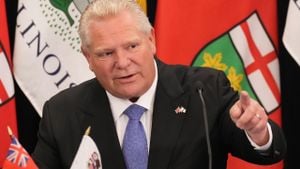The recent assembly elections have rocked Maharashtra, leaving many political analysts scratching their heads and trying to make sense of the outcomes. This year's election saw tensions flare, especially among the major players on the political stage, primarily the Shiv Sena (Uddhav Bal Thackeray faction), Bharatiya Janata Party (BJP), and the Nationalist Congress Party (NCP). The results have highlighted not just the shifting allegiances but also the growing discontent among the electorate.
One notable aspect of this election was the significant emergence of young candidates. Political observers noted the energy and enthusiasm brought by fresh faces, particularly from the Shiv Sena (UBT). These candidates managed to resonate with younger voters who are increasingly disillusioned with the traditional political narratives. This shift is important as the youth population plays a pivotal role during elections, presenting both opportunities and challenges for established political entities.
Sharad Pawar, veteran politician and NCP chief, has been under the microscope following the election's results. His political strategies have come under severe scrutiny, often labeled as the 'third tactical error' of his lengthy political career. Analysts argue his inability to unite factions within his party and the broader coalition contributed directly to the NCP's underwhelming performance.
Maharashtra's political climate has been increasingly characterized by unexpected alliances and splits. Raj Thackeray's Maharashtra Navnirman Sena (MNS) has found itself at the center of discussions. Some political commentators argue his party's involvement had mixed consequences—while it garnered votes for the Shiv Sena (UBT) in certain constituencies, it also diverted supporters away from parties like the NCP, which suffered likely due to fragmented anti-BJP votes.
Meanwhile, Political analysts also pointed out, the voters’ sentiments spoke volumes. Issues such as unemployment, inflation, and infrastructure development took center stage during the electoral discourse. Parties offering tangible solutions gained the upper hand, recalling how the BJP leveraged issues effectively during its campaigns.
The aftermath of these elections has not only left the political elite reeling but also raised questions about the future of alliance politics in Maharashtra. The backdrop against which these elections were fought was marred by incidents of violence and unrest—reported stone-pelting included incidences near polling stations, leading to heightened security concerns. The Samajwadi Party (SP) and its spokesperson Akhilesh Yadav remarked on the violence. Still, the reasons behind the unrest appeared to stem from larger socio-economic discontent.
Uddhav Thackeray, leader of the Shiv Sena (UBT), expressed his disappointment with the election results, sharing sentiments of shame. His party's diminishing power compared to previous elections reflected the necessity for introspection. Thackeray believes this disheartening performance necessitates review and overhaul of strategy moving forward.
Among the different factions, the ruling BJP has claimed significant victories across numerous constituencies, solidifying its presence. Party leaders are confident and believe the state will see continued development under their stewardship. Observers have noted how smoothly the BJP utilized its resources, emphasizing developmental projects which seemingly swayed much of the electorate.
Now it's time for Maharashtra’s political heavyweight to reevaluate their strategies, especially the non-BJP parties. Moving forward, efforts to form more cohesive alliances must be prioritized to challenge the BJP’s growing influence. Insights from this election should steer young and progressive leadership within these parties as they strive to connect with and mobilize the electorate.
Every election lays down the groundwork for future political shifts, and this one is no different. The Maharashtra Assembly Election brings focus back to the drawing board for many parties, igniting debates about inclusivity, youth engagement, and policy-driven politics. The aftermath is sure to spark conversations on caste dynamics and electoral strategies as Maharashtra prepares for what lies beyond this electoral battle.
With the dust settling on this tumultuous election, Maharashtra is at the cusp of potential restructuring within its political parties. Will the established parties reevaluate their approaches based on the electorate's mood, or will they stick to traditional strategies going forward? Only time will tell as the state gears up for its next political chapter.



